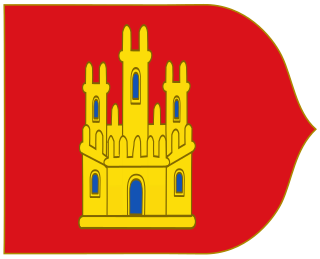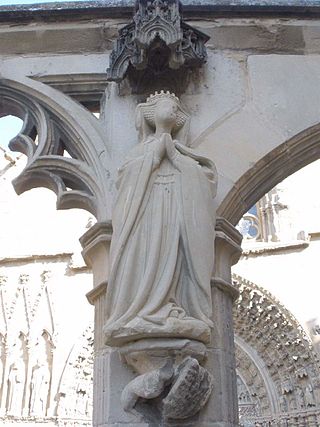
Eleanor is a feminine given name, originally from an Old French adaptation of the Old Provençal name Aliénor. It was the name of a number of women of royalty and nobility in western Europe during the High Middle Ages. The name was introduced to England by Eleanor of Aquitaine, who came to marry King Henry II. It was also borne by Eleanor of Provence, who became Queen consort of England as the wife of King Henry III, and Eleanor of Castile, wife of Edward I.

Charles III, called the Noble, was King of Navarre from 1387 to his death and Count of Évreux in France from 1387 to 1404, when he exchanged Évreux for the Duchy of Nemours.
A queen dowager or dowager queen is a title or status generally held by the widow of a king. In the case of the widow of an emperor, the title of empress dowager is used. Its full meaning is clear from the two words from which it is composed: queen indicates someone who served as queen consort, while dowager indicates a woman who continues to hold the title from her deceased husband. A queen mother is a former queen consort, often a dowager queen, who is the mother of the reigning monarch.

The Kingdom of Castile was a polity in the Iberian Peninsula during the Middle Ages. It traces its origins to the 9th-century County of Castile, an eastern frontier lordship of the Kingdom of León. During the 10th century, the Castilian counts increased their autonomy, but it was not until 1065 that it was separated from León and became a kingdom in its own right. Between 1072 and 1157, it was again united with León, and after 1230, this union became permanent. Throughout this period, the Castilian kings made extensive conquests in southern Iberia at the expense of the Islamic principalities. The Kingdoms of Castile and of León, with their southern acquisitions, came to be known collectively as the Crown of Castile, a term that also came to encompass overseas expansion.
Urraca is a female first name. In Spanish, the name means magpie, derived perhaps from Latin furax, meaning "thievish", in reference to the magpie's tendency to collect shiny items. The name may be of Basque origin, as suggested by onomastic analysis.

Alfonso of León, Lord of Molina was an infante (prince) of León and Castile, the son of King Alfonso IX of León and his second wife Queen Berengaria of Castile. He was the brother of King Ferdinand III of Castile and León, and father of Queen Maria of Molina, wife of King Sancho IV. He became Lord of Molina and Mesa after his first marriage to Mafalda González de Lara, the heiress of those lands.

Eleanor of Portugal, was a Portuguese infanta by birth and Queen of Aragon from 1347 to 1348 as the second wife of King Peter IV.
Eleanor or Leonor of Portugal is the name of:
Maria of Aragon may refer to:

The House of Trastámara was a royal dynasty which first ruled in the Crown of Castile and then expanded to the Crown of Aragon in the late middle ages to the early modern period.

Blanche I was Queen of Navarre from the death of her father, King Charles III, in 1425 until her own death. She had been Queen of Sicily from 1402 to 1409 by marriage to King Martin I, serving as regent of Sicily from 1404 to 1405 and from 1408 to 1415.
Maria of Portugal is the name of several Portuguese queens, queens consort, princesses and infantas, some of whom reigned as Queen of Spain or other lands:

Violant or Violante of Aragon, also known as Yolanda of Aragon, was Queen consort of Castile and León from 1252 to 1284 as the wife of King Alfonso X of Castile.

Ferdinand II was King of Aragon from 1479 until his death in 1516. As the husband of Queen Isabella I of Castile, he was also King of Castile from 1475 to 1504. He reigned jointly with Isabella over a dynastically unified Spain; together they are known as the Catholic Monarchs. Ferdinand is considered the de facto first king of Spain, and was described as such during his reign, even though, legally, Castile and Aragon remained two separate kingdoms until they were formally united by the Nueva Planta decrees issued between 1707 and 1716.
Isabella of Aragon may refer to:

Blanche is a feminine given name. It means "white" in French, derived from the Late Latin word "blancus". It possibly originated as a nickname or descriptive name for a girl with blonde hair or extremely fair skin. It has been in use since the medieval era, influenced by Blanche of Navarre and her descendants who married into European royal houses.
Eleanor or Leanor of Aragon may refer to:
Isabella of Castile most often refers to Queen Isabella I (1451–1504).

The Infantes of Aragon is an appellation commonly used by Spanish historians to refer to a group of 15th-century infantes (princes) of the House of Trastámara, specifically the sons of King Ferdinand I of Aragon and his wife Eleanor of Alburquerque:
This page is based on this
Wikipedia article Text is available under the
CC BY-SA 4.0 license; additional terms may apply.
Images, videos and audio are available under their respective licenses.










